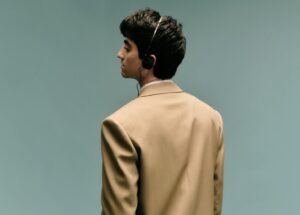Pierre Cardin’s Spring 2025 Ready-to-Wear collection debuted at Paris Fashion Week to mixed reviews, with the legendary fashion house opting to stay firmly rooted in its heritage. The collection, which channeled the brand’s iconic space-age aesthetic from the 1960s and 1970s, demonstrated a keen understanding of the house’s history, but it also raised questions about its relevance in today’s fast-paced and ever-evolving fashion industry. With fashion increasingly leaning towards innovation and adaptability, Cardin’s insistence on preserving its retro-futuristic codes left many wondering if the house is holding on too tightly to a nostalgic vision of the future.
The show was staged in a minimalist, metallic setting that immediately invoked the visual language of outer space. Models walked down a runway bathed in cool blue and silver hues, reminiscent of the chrome-drenched sets of classic sci-fi films. It was a clear nod to the avant-garde imagery that once made Cardin a trailblazer, but in 2025, it felt almost like an anachronism—a relic of an era that promised flying cars and intergalactic travel by the turn of the millennium. The collection’s reliance on familiar silhouettes and space-age motifs, such as geometric shapes and stiff, glossy materials, signaled a desire to reaffirm its identity, yet it did little to push the envelope or offer a fresh perspective on what futuristic fashion could mean today.
The Legacy of Pierre Cardin’s Space-Age Aesthetic
Pierre Cardin’s original space-age aesthetic, which emerged in the 1960s, was nothing short of revolutionary. His designs defied convention by incorporating unorthodox materials like metal and vinyl, as well as experimenting with sculptural forms that seemed to defy gravity. These creations captured the optimism of the space race and the excitement surrounding technological advancement, positioning Cardin as a visionary who looked not just to the present, but to a bold new future.
However, the future that Cardin envisioned has long since passed, and the contemporary fashion landscape has shifted dramatically. While brands like Balenciaga and Raf Simons have successfully incorporated elements of futurism into their collections, they have done so through a lens that acknowledges the present and anticipates the near future. Cardin’s Spring 2025 collection, on the other hand, seemed to inhabit a time capsule—one that celebrates a bygone era’s idea of the future rather than engaging with the possibilities of tomorrow.
Design Analysis: Repeating Old Codes
The Spring 2025 collection consisted primarily of sculpted mini-dresses, stiff tunics, and metallic jumpsuits, all of which echoed the design language that Cardin pioneered decades ago. The garments featured sharp lines, circular cutouts, and bold, solid color blocks of red, blue, and white. Materials like PVC, shiny vinyl, and metallic leather were prevalent, reinforcing the aesthetic of a future seen through the lens of mid-20th century idealism. While these elements are unmistakably Pierre Cardin, their execution felt more like a rehash than a reinvention.
One standout look—a cylindrical mini-dress with exaggerated shoulder pads and reflective silver paneling—could have easily been pulled from one of Cardin’s 1969 collections. The dress, while expertly constructed, felt like an artifact rather than a contemporary piece. Similarly, the collection’s reliance on oversized headpieces, angular visors, and metallic accessories evoked the novelty of the original space-age aesthetic without offering new insights or applications.
The collection’s menswear pieces were equally tethered to the past. Sleek, zip-up jumpsuits paired with knee-high metallic boots and glossy, astronaut-inspired jackets spoke to the same nostalgic narrative. There was an undeniable polish and sophistication to the garments, but they seemed more suited for a museum exhibit on the fashion of the 1960s than for today’s runways. The lack of experimentation with modern materials and techniques—such as incorporating technical fabrics or 3D printing—meant that the collection failed to engage with the futuristic possibilities that today’s technology offers.
Stuck in the Past: The Pitfalls of Nostalgia in Fashion
The crux of the problem lies in Pierre Cardin’s apparent unwillingness to break free from its own legacy. The Spring 2025 collection seemed almost afraid to stray from its historical roots, resulting in pieces that felt overly cautious and, at times, repetitive. This is a risky position for any fashion house to take, especially one that once prided itself on being at the cutting edge of innovation.
Fashion is inherently forward-looking, and while references to the past can ground a collection in tradition and identity, they should serve as a launchpad rather than an anchor. Cardin’s decision to stick closely to its established codes comes across as a missed opportunity to reinterpret and modernize the space-age aesthetic in a way that resonates with today’s audiences. While the collection’s craftsmanship and technical precision are commendable, they are not enough to compensate for the lack of conceptual progression.
Moreover, the Spring 2025 collection fails to address the societal and environmental concerns that are shaping contemporary fashion. Today’s designers are increasingly focused on sustainability, ethical production, and the social implications of their work. By contrast, Cardin’s emphasis on synthetic, non-biodegradable materials and its celebration of a fantastical vision of progress feel tone-deaf in a world where fashion’s impact on the environment is under intense scrutiny.
Missed Opportunities for Modernization
There are ways in which Pierre Cardin could have modernized its space-age aesthetic while staying true to its roots. One approach could have been to incorporate new technologies, such as smart fabrics that react to body temperature or garments embedded with LED lights and e-textiles that offer interactivity. Such innovations would have breathed new life into the space-age aesthetic, emphasizing its relevance in the present day.
Alternatively, the collection could have explored themes of post-humanism or the integration of technology and biology—topics that are gaining traction in both fashion and technology sectors. By addressing these contemporary issues through a futuristic lens, Pierre Cardin could have offered a collection that felt both grounded in its heritage and responsive to the current discourse surrounding technology’s role in shaping human identity.
Additionally, Cardin could have reinterpreted its iconic silhouettes using sustainable materials and production methods. The juxtaposition of retro-futuristic shapes with environmentally conscious fabrics would have sent a powerful message about the evolving relationship between fashion, technology, and sustainability. Such an approach would have demonstrated that the house is not merely celebrating a vision of the future but is actively engaging with the future of fashion.
Impression
The critical reception of Pierre Cardin’s Spring 2025 collection has been polarized. Some fashion critics praised the house’s dedication to its aesthetic and its refusal to follow fleeting trends. They argued that the collection serves as a reminder of Cardin’s lasting influence on fashion and the power of a well-defined brand identity. In a landscape where many fashion houses pivot towards new themes each season, Pierre Cardin’s consistency can be seen as a mark of integrity and respect for its heritage.
However, other critics viewed the collection as an unfortunate example of a brand stuck in a creative rut. They contended that while the collection is visually impressive, it lacks relevance and fails to push the conversation forward. The concern is that Pierre Cardin’s adherence to its historical codes has become a hindrance rather than a strength, preventing it from adapting to the changing dynamics of the fashion world.
Even among fans of the brand, there is a sense of frustration that the house is not doing more to build upon its legacy. Many long-time followers of Cardin’s work appreciate the iconic shapes and futuristic sensibilities but wish to see these elements reimagined in ways that feel fresh and surprising. The disappointment lies not in what the collection includes, but in what it leaves out—namely, a sense of discovery and innovation that made Pierre Cardin a household name in the first place.
The Spring 2025 collection raises important questions about the future of the Pierre Cardin brand. As fashion continues to evolve at a rapid pace, with new technologies and social movements influencing every aspect of the industry, the house will need to decide how to position itself. Will it continue to rely on its retro-futuristic codes, or will it find ways to reinterpret its legacy in ways that resonate with today’s—and tomorrow’s—fashion enthusiasts?
One path forward could involve collaborating with younger designers or artists who bring fresh perspectives to the brand’s heritage. By inviting outside voices to reinterpret the space-age aesthetic, Pierre Cardin could infuse its collections with new energy and ideas, ensuring that its legacy remains vibrant and relevant.
Another option is for the brand to embrace a more experimental approach, using its fashion shows as platforms for exploring speculative futures rather than merely referencing past visions of tomorrow. This could involve incorporating elements of performance art, virtual reality, or even AI-generated designs to create immersive experiences that challenge conventional notions of fashion.
Pierre Cardin’s Spring 2025 Ready-to-Wear collection is a testament to the enduring appeal of the brand’s space-age aesthetic. It showcases the craftsmanship and design language that made the house a pioneer in the 20th century. Yet, in its steadfast adherence to its retro-futuristic codes, the collection also reveals the limitations of nostalgia in an industry that prizes innovation and relevance.
The challenge for Pierre Cardin moving forward will be to strike a balance between honoring its past and embracing the possibilities of the future. The Spring 2025 collection, while visually striking, ultimately serves as a reminder that fashion must continue to evolve, just as the world it inhabits does. To reclaim its status as a leader in avant-garde fashion, Pierre Cardin will need to reimagine
No comments yet.







